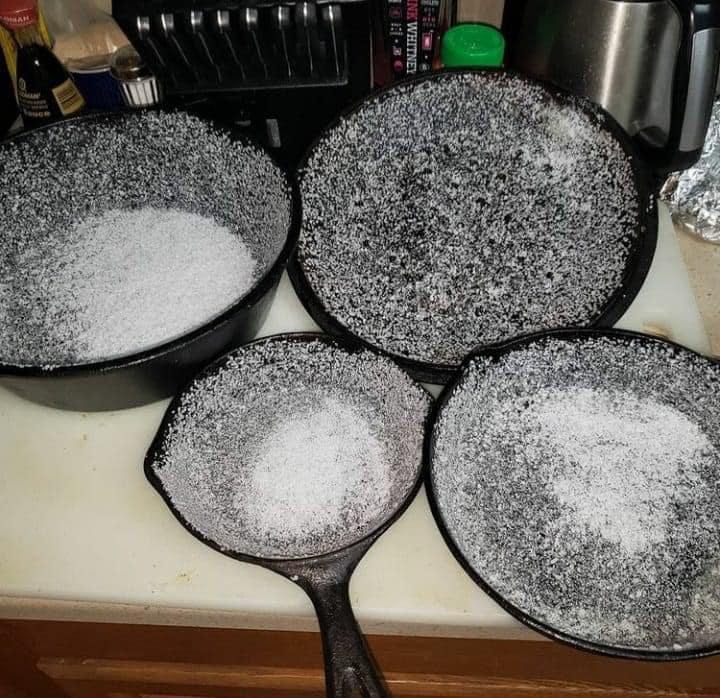ADVERTISEMENT
Step-by-Step Guide to Cleaning Your Cast Iron Skillet
1. Clean Immediately After Use
One of the best practices when caring for your cast iron skillet is cleaning it right after use, while it’s still warm (but not too hot). This helps to prevent food from sticking and makes it easier to clean.
- For Light Cleaning: If your skillet is only slightly dirty, a simple wipe-down with a clean paper towel or cloth should suffice. If food bits are stuck, you can scrub it with a little bit of coarse salt and a soft cloth or sponge. The salt acts as an abrasive, helping to lift off any residue.
- For Stubborn Residue: If there is stubborn food stuck to the skillet, fill the pan with a small amount of water (just enough to cover the bottom) and heat it on the stovetop for a few minutes. The steam will help loosen the food. Afterward, use a brush or sponge to scrub it away. For tougher stains, you can use a small amount of mild dish soap—though most cast iron experts recommend avoiding soap regularly, as it can strip away the seasoning. Use it sparingly if necessary.
2. Dry Immediately
Once the skillet is clean, dry it thoroughly with a towel or paper towel. It’s crucial to get rid of any moisture to prevent rust. If the skillet is still damp, place it back on the stovetop over low heat for a few minutes to completely dry it out.
3. Re-Seasoning After Cleaning
To keep your cast iron skillet in top condition, you need to maintain its seasoning layer. Seasoning is the layer of oil that is baked into the surface of the pan, creating a non-stick coating and protecting it from rust. After cleaning and drying your skillet, it’s a good idea to apply a thin layer of vegetable oil, canola oil, or flaxseed oil to the surface.
- How to Season Your Skillet: Pour a small amount of oil into the skillet and use a paper towel to spread it evenly over the entire surface, including the handle and exterior. Place the skillet upside down in the oven at 450°F (230°C) for 1 hour, with a layer of aluminum foil on the rack below to catch any drips. Let the skillet cool completely before storing.
This process builds up the seasoning layer over time, making the surface more non-stick and more resistant to rust.
Common Mistakes to Avoid
- Using Soap Regularly: While a small amount of mild dish soap is okay for removing stubborn grime, it’s best to avoid using soap regularly on your cast iron skillet as it can strip away the seasoning. Instead, rely on hot water, salt scrubbing, and the occasional use of a mild scrubber or sponge.
- Letting It Soak: Never soak your cast iron skillet in water for long periods, as this promotes rust. If food is stuck and requires soaking, don’t leave it submerged for hours—just long enough to loosen the bits.
- Cooking Acidic Foods Too Often: Cooking highly acidic foods, like tomatoes or citrus, in cast iron can break down the seasoning over time. While it’s okay to cook them occasionally, avoid using your cast iron skillet for acidic foods every day.
How to Fix Rust on Your Cast Iron Skillet
Over time, your cast iron skillet might develop a layer of rust, especially if it’s not properly dried or stored. Don’t worry, though—rust can be removed!
Steps to Remove Rust:
- Scrub the Rust: Use a steel wool scrubber or a wire brush to scrub the rust off. You may need to apply a bit of elbow grease, but it will come off. Make sure to scrub all areas of the skillet, including the handle.
- Wash and Dry: After removing the rust, wash the skillet with warm water and a little soap if necessary. Dry it immediately.
- Re-Season: After you’ve removed the rust and dried the skillet, follow the seasoning steps above to restore its protective layer.
Storage Tips for Cast Iron
Proper storage is key to maintaining your cast iron skillet’s longevity. Here are some storage tips:
- Store in a Dry Place: Cast iron should be stored in a dry environment to avoid rusting. Make sure it’s thoroughly dried after cleaning.
- Use a Paper Towel: After seasoning, place a paper towel inside the skillet before storing it to absorb any moisture and prevent rust.
- Hanging or Storing Flat: You can hang your cast iron skillet by its handle or store it flat in a cupboard. If stacking it with other pots and pans, place a layer of paper towel or cloth between them to avoid scratching.
Final Thoughts: How to Make Your Cast Iron Skillet Last a Lifetime
Cast iron skillets are one of the most durable pieces of cookware you can own. They improve with use and can last for generations when properly maintained. By following these simple cleaning and seasoning steps, avoiding common mistakes, and fixing rust promptly, you’ll keep your skillet in tip-top shape for years.
The effort you put into maintaining your cast iron skillet is rewarded with a cooking surface that gets better with age—creating beautiful, evenly cooked meals every time. So embrace the joy of cooking with your cast iron skillet, and enjoy its versatility, longevity, and delicious results!
ADVERTISEMENT
ADVERTISEMENT
